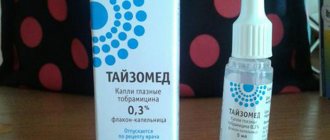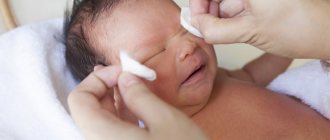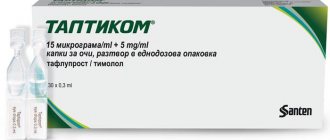Okomistin eye drops
The drug is a local antiseptic used in ophthalmology. It has an effect on bacterial pathogens, has an anti-inflammatory effect, and reduces the risk of complications after operations. The drug can be used for diseases of the auditory and respiratory tract, and for the herpes virus. It speeds up healing and shortens treatment time.
Composition and release form
Eye drops are a sterile transparent liquid containing the following components (per 1 milliliter of 0.01% solution):
| Active substance: benzyldimethyl ammonium chloride monohydrate (calculated as anhydrous) | 0.1 mg |
| Excipients: sodium chloride purified water | 9 mg up to 1 ml |
The drug is available in bottles with screw caps with first opening control or rubber stoppers, with a volume of 5, 10, 20 ml. They are made of polymer material or glass and equipped with a dropper. Eye drops can be packaged in disposable polyethylene dropper tubes of 1 and 1.5 ml. The drug is sold in a cardboard box containing 5, 10 tubes, 1, 5 bottles, along with instructions.
Pharmacodynamics and pharmacokinetics
The active ingredient miramistin causes the antimicrobial effect of the drops. The drug is effective against anaerobic, aerobic, gram-positive and gram-negative bacteria present in the form of individual cultures and microbial associations. It has a depressing effect on hospital strains that are multiresistant to antibiotics.
Miramistin is effective against streptococci, staphylococci and other gram-positive microflora. It is used in the presence of pathogenic fungi, adenoviruses, herpes viruses and human immunodeficiency. The drug has a detrimental effect on:
- chlamydia;
- gonococci;
- Treponema pallidum;
- Trichomonas;
- other pathogens of sexually transmitted diseases.
The inhibitory effect on microorganisms is based on the ability of miramistin to interact with cell surface molecules. This causes the destruction of membrane lipids. The cell becomes permeable to substances with a large mass. The activity of enzyme systems is inhibited, which causes suppression of the viability of microorganisms and their destruction.
Miramistin has a highly selective action and does not affect human cells. The drug reduces the resistance of bacteria, fungi and viruses to antibiotics. Benzyldimethyl has an anti-inflammatory effect. It stimulates regeneration processes, local protective reactions, activates the immune response, and accelerates recovery. The active substance is practically not absorbed into the systemic circulation.
Is Okomistin an antibiotic or not?
The drug has an antimicrobial effect against a wide range of microorganisms, but is not an antibiotic. It has virtually no side effects and is not absorbed into tissues. This facilitates the use of the drug in pediatric practice. Drops can be used simultaneously with antibiotics, enhancing their effect and reducing treatment time.
Indications for use
Eye drops are recommended for use in the following conditions:
- infectious processes of the anterior part of the eye (conjunctivitis, blepharoconjunctivitis, keratitis, keratouveitis);
- bacterial conjunctivitis and prevention of ophthalmia in children over 3 years of age;
- eye injuries, thermal, chemical burns;
- measures to prevent purulent-inflammatory complications before and after surgery;
- acute and chronic sinusitis, rhinosinusitis, rhinitis;
- external acute and chronic otitis media;
- chronic purulent mesotympanitis;
- otomycosis, herpes virus.
Best before date
The shelf life of Okomistin is 36 months from the production date, which can be found both on the cardboard box and in the instructions and on the plastic dropper bottle with the drug. After opening the bottle, the medicine must be used within a month . The drug should be stored at a temperature not exceeding +25 °C. Changes in temperature do not affect the properties of the drug. But deviation from the regulatory storage conditions, that is, increase and storage at a temperature higher than +25 ° C, is allowed once and for no more than 24 hours.
Information about the production date on the packaging indicates the day, month and year until which the medicinal product in unconcealed packaging complies with GOST and can be used for medicinal purposes. That is, a few days before the end date of this date, the drug can be used.
When purchasing, you must pay attention to the absence of defects and the date of manufacture. The latter should be well printed and easy to read. To determine whether a drug is expired, you first need to look at the expiration date. It is necessary to ensure the integrity of the plastic bottle - dropper. Okomistin drops are available in the form of a colorless, transparent liquid. The presence of sediment, flakes or other foreign inclusions indicates that the drug is defective and is not suitable for use, even if the expiration date has not expired. After the expiration date, the drug dries out for some time, leaving a white coating at the bottom of the bottle.
After the expiration date , Okomistin drops must be disposed of, since after this expiration date, the preservative that is in the drops and maintains sterility ceases to act and pathogenic microflora begins to multiply in the drug. Such a drug is not only useless, but can also cause irritation, an allergic reaction and harm to the body as a whole. The decomposition and oxidation of the components that make up the droplets also begins.
Instructions for use Okomistin
During treatment, the drug is used 1-2 drops inside the conjunctival sac 4-6 times a day until recovery. For prophylaxis, the medicine is prescribed 2-3 days before surgery and for 10-15 days after it. In this case, the drug is used 1-2 drops 3 times a day. When treating burns, the eyes are washed with water, then the medicine is instilled every 5-10 minutes for 1-2 hours, then it is used according to the standard regimen.
For acute and chronic sinusitis, rhinosinusitis, rhinitis, Okomistin is instilled into the nose 4-6 times a day for 14 days. For the treatment of external otitis and otomycosis, the medicine is prescribed 5 drops into the external auditory canal 4 times a day. You can insert a gauze swab moistened with the drug inside. The course of treatment is 10 days. For chronic mesotympanitis, the drug is used with hardware ultrasonic irrigation along with antibiotics.
Miramistin is used for bacterial conjunctivitis in children over 3 years of age. It is prescribed 1 drop up to 6 times a day for 7-10 days. To prevent ophthalmia, use 1 drop of the drug 3 times with breaks of 2-3 minutes. Before instillation, you must wash your hands. If there is no positive dynamics or complications occur on the 3-4th day of treatment, you should consult a doctor.
INDICATIONS FOR USE
Ophthalmology
Okomistin®, eye, ear, nasal drops are recommended for use in complex
treatment of infectious processes in the anterior part of the eye (blepharitis, conjunctivitis,
keratitis, keratouveitis), eye injuries, eye burns (thermal and chemical); V
preoperative and postoperative periods for the treatment and prevention of purulent inflammatory eye lesions.
Prevention of ophthalmia of newborns, including gonococcal and chlamydial.
Otorhinolaryngology
The drug is used in the complex treatment of acute sinusitis/rhinosinusitis, exacerbation
chronic sinusitis/rhinosinusitis, acute rhinitis; acute and chronic external
otitis, chronic purulent mesotympanitis, otomycosis.
special instructions
When using contact lenses, they should be removed and put on no earlier than 10-20 minutes after using the drug. It is recommended to refrain from driving vehicles and other potentially dangerous activities that require increased concentration, quick, accurate reactions and good visual acuity for 30 minutes after instilling the medicine.
The tip of the dropper should not come into contact with the mucous membrane of the eye, eyelashes, or skin. To prevent contamination and cross-infection, do not use the same vial at a time to treat infections of the eye, nose, or ear. It is not recommended to use one dropper by several people to prevent the spread of infection.
Contraindications
The use of the drug is contraindicated in the following situations (to predict and adjust individual reactions to treatment, you must first consult with your doctor):
- children under 3 years of age (during treatment of bacterial conjunctivitis) and up to 18 years of age (in all other cases);
- pregnancy;
- breastfeeding period;
- sensitivity to active ingredients.
Analogs
There are a large number of effective analogues of Okomistin:
- Miramistin has a similar effect.
- Oftaquix contains levofloxacin and is effective against aerobic bacteria.
- Vitabact is active against some bacteria, fungi, and viruses.
- Tsiprolet is available in the form of drops, injection solution and tablets. It is an antibiotic and has a wide range of actions.
- Dancil – has an antimicrobial effect.
- Oftadek is an antimicrobial agent.
- Signicef is used to detect aerobic bacteria, chlamydia.
pharmachologic effect
The main active ingredient of the drug Okomistin® is the antiseptic benzyldimethyl-myristoylamino-propylammonium, which has a pronounced antimicrobial effect against gram-positive and gram-negative, aerobic and anaerobic bacteria in the form of monocultures and microbial associations, including hospital strains with multidrug resistance to antibiotics.
The action of benzyldimethyl-myristoylamino-propylammonium is based on the direct hydrophobic interaction of the molecule with the lipids of the membranes of microorganisms, leading to their fragmentation and destruction. In this case, part of the benzyldimethyl-myristoylamino-propylammonium molecule, plunging into the hydrophobic portion of the membrane, destroys the supra-membrane layer, loosens the membrane, increases its permeability for large-molecular substances, changes the enzymatic activity of the microbial cell, inhibits enzyme systems, which leads to inhibition of the vital activity of microorganisms and their cytolysis.
Benzyldimethyl-myristoylamino-propylammonium has a high selectivity of action against microorganisms, because has virtually no effect on the membranes of human cells, which is due to the different structure of the latter - the significantly longer length of lipid radicals, which sharply limits the possibility of hydrophobic interaction of benzyldimethyl-myristoylamino-propylammonium with cells.
Under the influence of the drug, the resistance of bacteria and fungi to antibiotics is reduced. Benzyldimethyl-myristoylamino-propylammonium has anti-inflammatory and immunoadjuvant effects, enhances local protective reactions, regenerative processes, activates nonspecific defense mechanisms due to modulation of the cellular and local humoral immune response.
The active substance of Okomistin is the antiseptic benzyldimethyl, which has pronounced antimicrobial properties, which affects gram-positive and gram-negative, aerobic and anaerobic microorganisms (monocultures and microbial associations, including hospital strains multiresistant to antibiotics).
Okomistin is able to act on chlamydia, mycoses, herpes viruses, and adenoviruses. The drug is most effective against gram-positive microflora - staphylococci and streptococci. Under its influence, the resistance of fungi and bacteria to antibiotics is noticeably reduced.
Okomistin price
This drug can be purchased at all pharmacies. There is only one manufacturer - Infamed (Russian Federation). Approximate prices in Moscow:
| Drug name | Price, rubles |
| Eye drops 0.01%, No. 1 (10 ml) | 110-295 |
| Eye drops 0.01%, No. 5 (10 ml) | 130-455 |
| Eye drops 0.01%, 5 ml | 75-210 |
Release form
- Active substance: Benzyldimethyl[3-(myristoylamino)propyl]ammonium chloride monohydrate (in terms of anhydrous substance) - 0.01 g.
- Excipients: sodium chloride - 0.90 g, purified water up to 100 ml.
Eye drops, ear drops, nasal drops, 10 ml each in a polymer bottle in a cardboard pack
Dosage form – eye drops 0.01%: clear, colorless liquid (1 and 1.5 ml each in polymer tube-droppers for single use, in a cardboard pack 5 or 10 tubes; 5 and 10 ml each in polymer bottles, sealed with a dropper stopper and a screw cap with first opening control, in a cardboard pack of 1 or 5 bottles;
https://www.youtube.com/watch?v=ytpressru
Composition of 1 ml drops:
- active substance: benzyldimethyl [3-(myristoylamino)propyl]ammonium chloride monohydrate – 0.1 mg in terms of anhydrous substance;
- additional components: sodium chloride, purified water.
Clinical and pharmacological group: antiseptic for topical use in ophthalmology.










